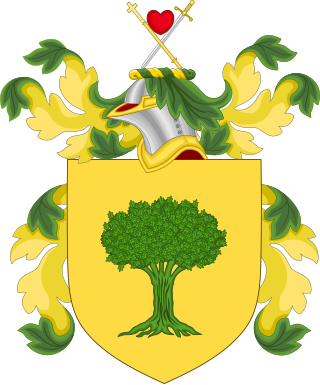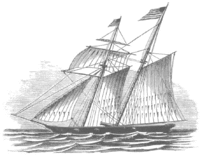
A clipper was a type of mid-19th-century merchant sailing vessel, designed for speed. Clippers were generally narrow for their length, small by later 19th-century standards, could carry limited bulk freight, and had a large total sail area. "Clipper" does not refer to a specific sailplan; clippers may be schooners, brigs, brigantines, etc., as well as full-rigged ships. Clippers were mostly constructed in British and American shipyards, although France, Brazil, the Netherlands, and other nations also produced some. Clippers sailed all over the world, primarily on the trade routes between the United Kingdom and China, in transatlantic trade, and on the New York-to-San Francisco route around Cape Horn during the California Gold Rush. Dutch clippers were built beginning in the 1850s for the tea trade and passenger service to Java.

A schooner is a type of sailing vessel defined by its rig: fore-and-aft rigged on all of two or more masts and, in the case of a two-masted schooner, the foremast generally being shorter than the mainmast. A common variant, the topsail schooner also has a square topsail on the foremast, to which may be added a topgallant. Differing definitions leave uncertain whether the addition of a fore course would make such a vessel a brigantine. Many schooners are gaff-rigged, but other examples include Bermuda rig and the staysail schooner.

A brig is a type of sailing vessel defined by its rig: two masts which are both square-rigged. Brigs originated in the second half of the 18th century and were a common type of smaller merchant vessel or warship from then until the latter part of the 19th century. In commercial use, they were gradually replaced by fore-and-aft rigged vessels such as schooners, as owners sought to reduce crew costs by having rigs that could be handled by fewer men. In Royal Navy use, brigs were retained for training use when the battle fleets consisted almost entirely of iron-hulled steamships.

The Bermuda sloop is a historical type of fore-and-aft rigged single-masted sailing vessel developed on the islands of Bermuda in the 17th century. Such vessels originally had gaff rigs with quadrilateral sails, but evolved to use the Bermuda rig with triangular sails. Although the Bermuda sloop is often described as a development of the narrower-beamed Jamaica sloop, which dates from the 1670s, the high, raked masts and triangular sails of the Bermuda rig are rooted in a tradition of Bermudian boat design dating from the earliest decades of the 17th century. It is distinguished from other vessels with the triangular Bermuda rig, which may have multiple masts or may not have evolved in hull form from the traditional designs.

The Pride of Baltimore was a reproduction of a typical early 19th-century "Baltimore clipper" topsail schooner, commissioned to represent Baltimore, Maryland. This was a style of vessel made famous by its success as a privateer commerce raider, a small warship in the War of 1812 (1812–1815) against British merchant shipping and the world-wide British Royal Navy. After the end of the war, Baltimore Clippers did not have sufficient cargo capacity for normal merchant trade, so some were used in the illegal opium trade into China and vessels of the same type were used in the transatlantic slave trade from Africa.

The Prince de Neufchatel was a fast sailing United States schooner-rigged privateer, built in New York by Adam and Noah Brown circa 1812. She is a fine example of the peak of development of the armed schooner. Neufchatel operated in mainly European waters, preying on British shipping during the War of 1812. Noted for her speed, at one time she outran seventeen men-of-war. In 1813, operating in the English Channel, she took nine British prizes in quick succession. She also delivered a crushing defeat to the boats of a British frigate that tried to capture her. The British finally captured her in December 1814; she was broken up in 1815.
John Ordronaux was one of the most successful privateers of the War of 1812 between the United States and the United Kingdom of Great Britain and Ireland. During the war he commanded two ships, Marengo, then Prince de Neufchatel. With these he captured or destroyed about thirty British merchant ships, outran about seventeen British warships and brought back goods to the US worth between $250,000 and $300,000. In August 1812, during his First Command with the Marengo, he captured a young Scotsman from the English ship Concord called James Swanston Miller (1798-1855) and stranded him unexpectedly on the island of Grand Canary. After this freak of chance, the Swanston and Miller families went on to build a famous and unplanned mercantile dynasty in the island which hugely boosted the local economy after the Napoleonic Wars and into the 20th century.

Thomas Boyle, an Irish American, as a captain of the schooner Comet and the clipper Chasseur, was one of the most successful Baltimore privateers during the War of 1812. He briefly served in the United States Navy during the same war.
Liverpool Packet was originally the American slave ship Severn, built at Baltimore and captured in 1811. She became a privateer schooner from Liverpool, Nova Scotia, that captured 50 American vessels in the War of 1812. American privateers captured Liverpool Packet in 1813, but she failed to take any prizes during the four months before she was recaptured. She was repurchased by her original Nova Scotia owners and returned to raiding American commerce. Liverpool Packet was the most successful privateer vessel ever to sail out of a Canadian port.
The maritime history of the United States (1800–1899) saw an expansion of naval activity.

Chasseur was a Baltimore Clipper commanded by Captains Pearl Durkee, William Wade (1813) and Thomas Boyle (1814-1815). She was one of the best equipped and crewed American privateers during the War of 1812.
USS Gallatin was a post-Revolutionary War sailing vessel that the U.S. Department of the Treasury purchased at Norfolk, Virginia, for the United States Revenue-Marine in December 1807. An explosion on board destroyed her in 1813.
HMS Highflyer was originally an American privateer schooner built in 1811. As a privateer she took several British vessels as prizes. The Royal Navy captured her in 1813. She then participated in several raids on the Chesapeake and coastal Virginia before the Americans recaptured her later in 1813.

HMS Mosquidobit was the Chesapeake-built six-gun schooner Lynx that the British Royal Navy captured and took into service in 1813. She was sold into commercial service in 1820 and nothing is known of her subsequent fate.
HMS Shelburne was the American letter of marque schooner Racer, built in Baltimore in 1811 and captured by the British in 1813. She served on the American coast, capturing the American brig Frolic. She also captured some merchantmen and was sold in Britain in 1817.
Many vessels have been named Comet, after the astronomical object comet.

Comet, an American schooner, was built in 1810 at Baltimore, Maryland. She was owned by "a group of wealthy Baltimore investors." Under Captain Thomas Boyle, who was a part owner of the schooner, Comet sailed from July 1812 to March 1814 as a privateer, which was a type of ships licensed by the United States during the War of 1812 to harass the British merchant vessels and divest their cargoes.
Thomas Kemp was a Baltimore shipbuilder, known for building some of the fastest and best known privateers of the War of 1812, such as Rossie, Comet, Patapsco, Chasseur, and Lynx.
HMS Berbice was a schooner, initially built for use as a merchant ship, that the Royal Navy purchased in the West Indies in 1780. Her most prominent service was as a naval tender to HMS Adamant, the flagship of Sir Richard Hughes in the Leeward Islands Station. She was formerly commissioned in July 1781, and from 1782 to 1783 she was commanded by Lieutenant Thomas Boulden Thompson. On 23 February 1782, naval records indicate that she was at English Harbour, in need of crewmen but otherwise ready for active duty.

Scottish Maid was a Scottish packet boat, a two-masted wooden schooner, built at Alexander Hall and Sons' boatyard in 1839 for the Aberdeen Line. She has been described as the first clipper vessel to be built in Britain. Her design of sharp, forward-raked bow, later called the "clipper bow" or Aberdeen bow, pioneered a succession of larger clipper ships with many also built in Aberdeen on Scotland's northeast coast.













